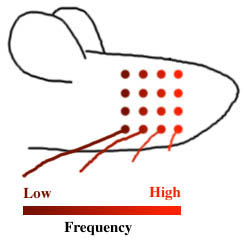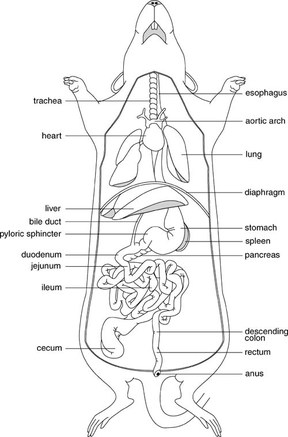- Rats are in the phylum Chordata and class Mammalia (both in the kingdom Animalia)
- Mammals have hair (or fur), have mammary glands to produce milk, and bear live young
- Looking externally, we saw that they have whiskers next to their noses, have long teeth in their mouths, have a nictitating membrane over their eyes to keep in moisture, have external ear parts called the pinna, have visible mammary glands, and all of ours were females
- Mammalian hearts have four chambers
- The diaphragm is a thin membrane of muscle separating the heart and lungs from the lower abdominal cavity
This week, we started by talking about research articles. In trying to decide what article to discuss, I knew there would be quite a lot of choices, since rats are a major research animal, and many studies on them are published all the time. So, I decided to make a list of how many articles were published in 2012 on each of several species or groups of species. Here's what I found by searching PubMed:
Number of articles pubished or accepted for publication in 2012 on
- Rats: 185,624
- Mice: 205,424
- Zebrafish: 4,510
- Drosophila melanogaster (fruit flies): 11,949
- Corn: 5,523
- Bacteria (in general): 180,158
- Viruses: 91,308
- Human: 1,242,225
 So we could see that people are very interested in researching ourselves! I discussed two articles about rats: one was about their whiskers, because people are interested in understanding how rats get information from their whiskers. There is an interesting area in the brain called the barrel cortex, and it is where information from each whisker goes to a special spot.
So we could see that people are very interested in researching ourselves! I discussed two articles about rats: one was about their whiskers, because people are interested in understanding how rats get information from their whiskers. There is an interesting area in the brain called the barrel cortex, and it is where information from each whisker goes to a special spot.
Next, we dissected the rats, and talked about several important things:
- There are two main body cavities: the thoracic and the abdominal
- In the thoracic cavity are the heart, lungs, trachea, esophagus, and ribs.
- The trachea is the rigid tube that goes from the mouth down to the lungs. It needs to stay open so we can breathe, and it branches into two bronchi.
- The esophagus is the soft tube that goes from the mouth down to the stomach.
- In the abdominal cavity are the stomach, liver, gall bladder, intestines, kidneys, bladder, pancreas, and spleen
- The diaphragm separates the two, but also is what allows us to breathe. When it moves down, we breathe in, and when it moves up, we breathe out. It is also responsible for the hiccups!
- The largest internal organ is the liver, and it has four lobes.
- The liver produces bile, which helps digest food. It is also why our poop is brown!
- The largest external organ is our skin!
- Some muscles that rats and humans have are the biceps, triceps, deltoids, obliques, quadriceps, latissimus dorsi, and abdominals
- Some bones we talked about were the femur, tibia, fibula, and the hip ball-and-socket joint
- The kidneys filter our blood, and if you have no working kidneys, you have to have dialysis to clean your blood. But one working kidney is enough, so you can donate one to someone else to save their life!

No comments:
Post a Comment